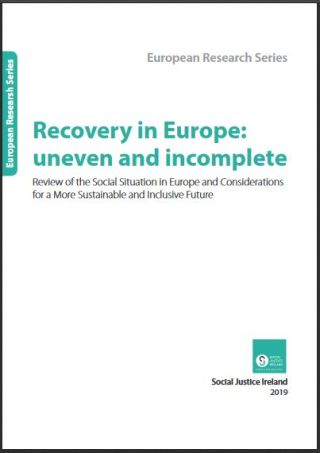Recovery in Europe: uneven and incomplete

A key response to the economic crisis has been the adoption by the European Council of the Europe 2020 Strategy in 2010, which set out to develop a more balanced and sustainable approach for the future and was designed to address the economic and financial crisis that had wiped out ‘years of economic and social progress’, while also exposing what were considered to be structural weaknesses in Europe’s economy.
The strategy was seen as a step forward in the development of EU policymaking, because it recognised the importance of social issues. It committed member states of Europe to work towards targets in a range of areas including on poverty and social exclusion, employment and education and established an agreed set of indicators designed to measure progress toward meeting those targets. The report refers to how well, or otherwise, Europe is doing relative to those targets.
Poverty, Social Exclusion and Income Inequality
Overall, while there have been some improvements in the latest years (2016-2017), Europe is still far off-track in relation to meeting its poverty reduction targets. The social indicators suggest little improvement for very many people living in Europe, with dis-improvements for some groups in several countries. These include older people in some countries, an issue that particularly affects older women. Those working who still live in poverty is another group to be concerned about and this issue now affects a greater proportion of people than it did in 2008. The position of children, in particular, while improved somewhat continues to be strikingly negative for very many children with potentially very serious long-term consequences. Thus, recovery has yet to be felt across social groups.
Employment and Unemployment
While the report shows welcome improvements in the employment situation in Europe, there are also some concerning issues with the way the nature of employment is evolving, a legacy of longterm unemployment and significant employment challenges facing young people, in particular, and some other groups, and there also continue to be divergent experiences across countries.
Key Services
While the quality of health care is high in most EU countries, there are significant variations between countries with regard both to quality and inclusivity. Based on an assessment of health systems for 2017, Sweden, Germany and Luxembourg hold the top three places followed by the Netherlands, Malta, Belgium, Czechia and France. Those performing worst were Latvia, Greece and Romania.
Other indicators that we have reviewed suggest that there have been improvements in respect of access to, and perceptions of quality of, health services in recent years, and this is welcome. But, unfortunately, in several countries, participants rated the quality of health services less favourably in 2016 than in 2011 (Latvia, Slovenia, Cyprus, Greece, U.K. and Belgium).
Furthermore, perceptions of unmet need for health care and perceptions of poorer quality of healthcare continue to be greater amongst poorer people in Europe than richer. There also continues to be great variation in these perceptions across different countries. This means that despite the economic recovery, certain groups, such as those with low-incomes, need a special focus to ensure that they benefit from general improvements and that the health systems and policies pursued in some countries need ongoing improvement.
Taxation
In general, countries in the south and east of Europe tend to have lower levels of taxation and also less well-developed social investment approaches, and higher rates of poverty or social exclusion. Amongst the newer accession countries – and with a taxation ratio just below 35 per cent of GDP - Czechia is notable for its performance in relation to prevention of poverty or social exclusion.
The report concludes with some alternatives to the current policy framework, issues for discussion with policy makers that can create a more stable, and evenly spread recovery across Europe.
To view the full report, click HERE.

GIVING A VOICE TO THOSE
WHO DON’T HAVE A VOICE
When you support Social Justice Ireland, you are tackling the causes of problems.
